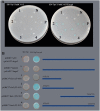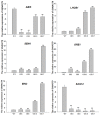An NAM Domain Gene, GhNAC79, Improves Resistance to Drought Stress in Upland Cotton
- PMID: 28993786
- PMCID: PMC5622203
- DOI: 10.3389/fpls.2017.01657
An NAM Domain Gene, GhNAC79, Improves Resistance to Drought Stress in Upland Cotton
Abstract
Plant-specific NAC proteins comprise one of the largest transcription factor families in plants and play important roles in plant development and the stress response. Gossypium hirsutum L. is a major source of fiber, but its growth and productivity are limited by many biotic and abiotic stresses. In this study, the NAC domain gene GhNAC79 was functionally characterized in detail, and according to information about the cotton genome sequences, it was located on scaffold42.1, containing three exons and two introns. Promoter analysis indicated that the GhNAC79 promoter contained both basic and stress-related elements, and it was especially expressed in the cotyledon of Arabidopsis. A transactivation assay in yeast demonstrated that GhNAC79 was a transcription activator, and its activation domain was located at its C-terminus. The results of qRT-PCR proved that GhNAC79 was preferentially expressed at later stages of cotyledon and fiber development, and it showed high sensitivity to ethylene and meJA treatments. Overexpression of GhNAC79 resulted in an early flowering phenotype in Arabidopsis, and it also improved drought tolerance in both Arabidopsis and cotton. Furthermore, VIGS-induced silencing of GhNAC79 in cotton led to a drought-sensitive phenotype. In summary, GhNAC79 positively regulates drought stress, and it also responds to ethylene and meJA treatments, making it a candidate gene for stress studies in cotton.
Keywords: GhNAC79; cotton; development; drought; stress.
Figures








Similar articles
-
Characterization and Functional Analysis of GhNAC82, A NAM Domain Gene, Coordinates the Leaf Senescence in Upland Cotton (Gossypium hirsutum L.).Plants (Basel). 2022 Jun 1;11(11):1491. doi: 10.3390/plants11111491. Plants (Basel). 2022. PMID: 35684264 Free PMC article.
-
Silencing GhJUB1L1 (JUB1-like 1) reduces cotton (Gossypium hirsutum) drought tolerance.PLoS One. 2021 Nov 5;16(11):e0259382. doi: 10.1371/journal.pone.0259382. eCollection 2021. PLoS One. 2021. PMID: 34739505 Free PMC article.
-
Glyceraldehyde-3-phosphate dehydrogenase Gh_GAPDH9 is associated with drought resistance in Gossypium hirsutum.PeerJ. 2023 Nov 23;11:e16445. doi: 10.7717/peerj.16445. eCollection 2023. PeerJ. 2023. PMID: 38025668 Free PMC article.
-
Genome-wide cloning, identification, classification and functional analysis of cotton heat shock transcription factors in cotton (Gossypium hirsutum).BMC Genomics. 2014 Nov 6;15(1):961. doi: 10.1186/1471-2164-15-961. BMC Genomics. 2014. PMID: 25378022 Free PMC article.
-
Characterization of the late embryogenesis abundant (LEA) proteins family and their role in drought stress tolerance in upland cotton.BMC Genet. 2018 Jan 15;19(1):6. doi: 10.1186/s12863-017-0596-1. BMC Genet. 2018. PMID: 29334890 Free PMC article.
Cited by
-
Functional characterization of GhNAC2 promoter conferring hormone- and stress-induced expression: a potential tool to improve growth and stress tolerance in cotton.Physiol Mol Biol Plants. 2024 Jan;30(1):17-32. doi: 10.1007/s12298-024-01411-2. Epub 2024 Feb 8. Physiol Mol Biol Plants. 2024. PMID: 38435854 Free PMC article.
-
LiNAC100 contributes to linalool biosynthesis by directly regulating LiLiS in Lilium 'Siberia'.Planta. 2024 Feb 23;259(4):73. doi: 10.1007/s00425-024-04340-2. Planta. 2024. PMID: 38393405
-
Characterization and Functional Analysis of GhNAC82, A NAM Domain Gene, Coordinates the Leaf Senescence in Upland Cotton (Gossypium hirsutum L.).Plants (Basel). 2022 Jun 1;11(11):1491. doi: 10.3390/plants11111491. Plants (Basel). 2022. PMID: 35684264 Free PMC article.
-
Transcriptomic and biochemical analyses of drought response mechanism in mung bean (Vignaradiata (L.) Wilczek) leaves.PLoS One. 2023 May 10;18(5):e0285400. doi: 10.1371/journal.pone.0285400. eCollection 2023. PLoS One. 2023. PMID: 37163521 Free PMC article.
-
Comparative Analysis of the Effect of Gamma-, Electron, and Proton Irradiation on Transcriptomic Profile of Hordeum vulgare L. Seedlings: In Search for Molecular Contributors to Abiotic Stress Resilience.Plants (Basel). 2024 Jan 23;13(3):342. doi: 10.3390/plants13030342. Plants (Basel). 2024. PMID: 38337875 Free PMC article.
References
-
- Bartels D., Sunkar R. (2005). Drought and salt tolerance in plants. Crit. Rev. Plant Sci. 24 23–58. 10.1080/07352680590910410 - DOI
LinkOut - more resources
Full Text Sources
Other Literature Sources

